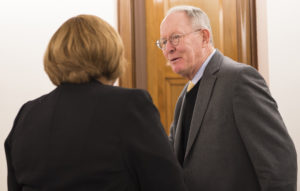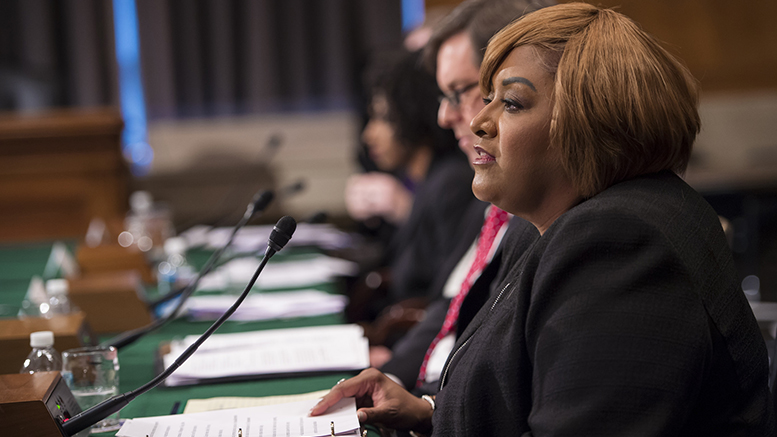DeRionne Pollard, who was the first in her family to attend college, held three part-time jobs and relied on food stamps while attending college. And though federal student aid was available, her father struggled to complete the application for federal aid.
Today, Pollard is president of Montgomery College (MC) in Maryland, and she advocates for many of her students who face those same challenges, as well as new ones.
Speaking Tuesday before a Senate committee that is preparing to draft legislation to reauthorize the Higher Education Act (HEA), Pollard — who also serves on the American Association of Community Colleges (AACC) board of directors — said many MC students drop out because they struggle to cover basic living expenses, including food, housing, transportation, child care, health care and more.
“We know that any of these extra expenses could break the budget of a student living on the edge,” Pollard said during the Senate Health, Education, Labor and Pensions Committee hearing.
MC has programs to address those barriers — such as food pantries, free shuttle buses, loaner laptops and open-educational resources to reduce textbook costs — but the federal government could provide more support to help these students, including tying the maximum Pell Grant amount to inflationary increases and allowing eligible students to use the grants for short-term programs, Pollard said.
“Pell grants are invaluable to getting students in the door to college, but the grants’ buying power has diminished so students must still work — many full time — to make ends meet,” she said.
Nationally, 22 percent of full-time students at community colleges work full-time, while 40 percent work part-time, according to AACC.
Legislative touch points
Before the speakers testified, the committee chair floated several ideas to improve the student aid system and its effectiveness that would not necessary require more federal funding. In additional to significantly streamlining the federal student aid application — which he has championed for years — Committee Chair Lamar Alexander (R-Tennessee) again suggested simplifying the two main higher education grant programs and five student loan programs, and redirecting some of those funds to high priorities, such as creating additional Pell grants.

Committee Chair Lamar Alexander greets DeRionne Pollard and other speakers prior to the hearing.
Alexander also noted competency-based education as an option that would help students complete a credential more efficiently, and he hinted at colleges bearing some of the risk for federal student aid.
“It makes no sense to spend taxpayer dollars in helping students earn degrees that are not worth their time and money, so schools should be held accountable for their students’ ability to repay their loans,” he said.
Alexander expects the committee to release its HEA legislation early this spring.
Getting states to contribute more
How to encourage states to contribute more toward higher education was another focus at the hearing. State investments in higher education dropped by 26 percent per student between 2008 and 2012, according to Robert Anderson, president of the State Higher Education Executive Officers. By 2016, funding had partially recovered but was still 15 percent below pre-recession levels, he said. Only four states had 2016 state and local funding exceed their 2008 levels.
To make up the difference in less state funding, colleges usually raise tuition, Anderson noted.
Some colleges, such as MC, have looked to localities to fill the gap to keep tuition in check. At one time, the college’s budget was equally funded by tuition, state and local funding, Pollard said. Today, half of its budget comes from the county, a third from students and about 15 percent from the state.
“That number has not changed in the last decade,” she said. “I think it’s essential to have that public-federal-state collaboration,” she said.
State funding can make a significant difference to student completion, as colleges can direct resources to help students succeed rather than using them to cover state funding shortfalls. Anderson cited a study that found a 10 percent increase in spending at community colleges helped to boost associate-degree completions by more than 10 percent and certificates by more than 23 percent.
Senate HEA hearing: Accountability at the program level
Zakiya Smith, strategy director at Lumina Foundation, encouraged a new type of federal-state partnership where the federal government would provide matching dollars to states that can meet affordability and quality guarantees.
“Without this kind of partnership with states and institutions, the federal government in effect tolerates continued state disinvestment and tuition increases, reducing the efficacy of the federal investment over time,” she said in her written testimony. “States can pull back on their commitment to aid and lower tuition, allowing for federal grants and loans to fill the gap for students.”
Anderson also would like to see a federal-state partnership that includes incentives for states to keep college costs low, especially for low-income students. But it would likely have federal funding implications.
“The federal investment must be sufficiently large to adequately leverage new state commitments, given that states may need to seek new revenue sources or change existing budget allocations,” he said in his written testimony.
Senate HEA hearing: Expanding competency-based education

